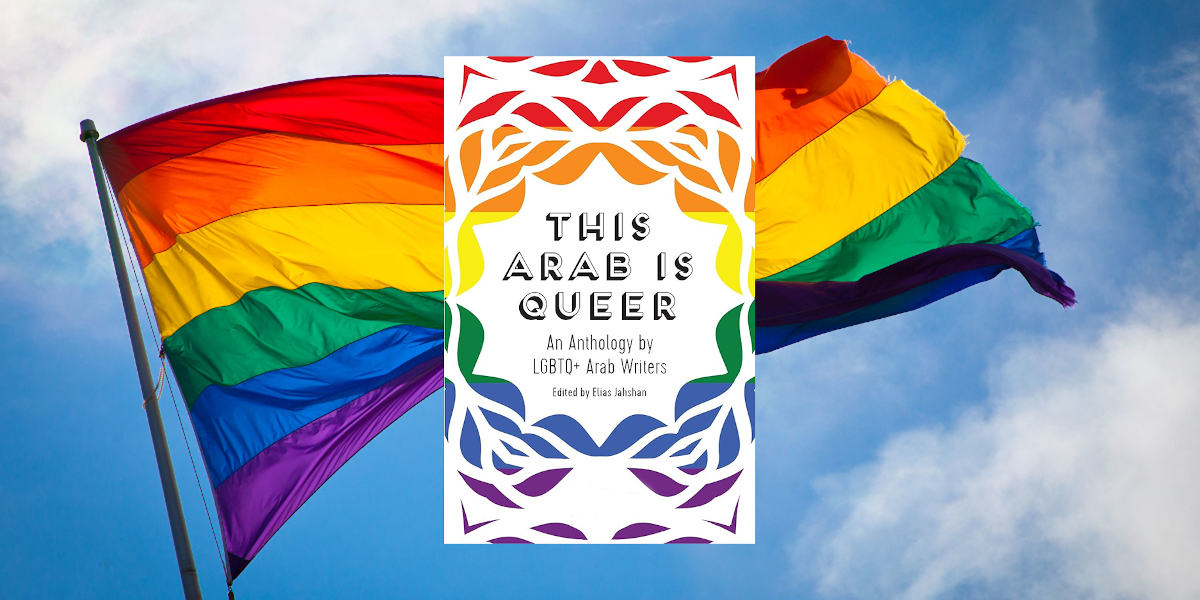Title: This Arab is Queer: An Anthology by LGBTQ+ Arab Writers
Editor: Elias Jahshan
Publisher: Saqi Books
Year: 2022
When you stand in front of a painting, you may only see the obvious at first. But when you look deeper and allow the painting to show you its layers, you see the hidden details, the hidden beauty and the love that painting might hold. The This Arab is Queer anthology is the same as a painting.
At first inspection, we see how pain and trauma are real, material, tangible things to the lives of queer Arabs. How our memories are unshakeable and stick with us in ways we do not realise. Many of the writers in the anthology express how they live in a constant state of uncertainty and their safety is never guaranteed. They have a constant push and pull from their outer world – parents, family, society – and their inner world, their heart and mind.
But looking deeply into these stories, we can see the glimmers of hope and resistance as queer Arabs courageously find love. There is beauty in the details, of unexpected friendships, of a lover with all the patience in the world, and of time, which of course can heal wounds. This anthology asks and answers many questions and allows individual experiences to come together and paint a broad picture about the lives of queer Arabs around the globe.
Memory and identity
One common thread in the anthology is memory and how the effects of our memories and experiences tamper with our hopes for the future. It is hard to recover from mental suffering. The walls we build around us to protect ourselves mean we cannot always see past them and envision a future of love and happiness. It leads to uncertainty but unfortunately these walls are needed sometimes.
In Dima Mikhayel Matta’s piece, This Text Is a Very Lonely Document, they write how they had to separate themselves from childhood memories in order to be able to create a space for new ones free from the influences of past trauma. They share that it is okay to forget distant memories and older versions of ourselves if it means that we can heal and love.
The queer, black Arab experience is one of constant challenge
Many other writers in the anthology detail memories as pivotal moments in their lives that they needed to be able to see their world in a new light, even if those memories involved pain and suffering. In Danny Ramadan’s The Artist’s Portrait of a Marginalised Man, they accept their past trauma and memories because they can now reflect on them, and use them as a platform for creating, writing and sharing stories.
Memories can be so intrinsic to our identities. They hold many complex feelings and we attach a lot of importance to them. Without memories, we cannot decide what we want or who we want to be. Many of the writers break that bond between memory and identity and question whether it is better to choose our memories, while others acknowledge that we need to accept them and take ownership. We cannot control our past but we can choose how much significance it will have to our present and future selves.
Being seen and heard
Naturally, many of us put ourselves in someone else’s shoes when listening to their stories in order to truly empathise and attempt to understand them. I found myself trying to do this while reading the anthology. I wondered what it feels like to be constantly hyper-aware and hyper-vigilant because of who I am and what I look like. To be so visible in spaces that want to rid you, like a mistake in a painting.
To be seen and be heard takes so much courage and can be beautiful but dangerous. At what cost do we need to be seen and heard? What part of our identity do we sacrifice and at what time or point? Where is it safe?
Amna Ali’s piece, My Intersectionality Was My Biggest Bully, brought some of these thoughts to my mind. To some of these writers, to be seen and heard isn’t a choice; it is a necessity to be their true authentic selves. But it comes with risks. Detailing their experiences and memories as a child and young adult, Amna Ali says that ‘the way the world around us sees us should never, in any way, dictate how we feel about ourselves’. This encapsulates how the queer, black Arab experience is one of constant challenge because of the multiple layers of their identity. But how the outer world views them should never be internalised. We should never sacrifice parts of ourselves to appease those around us, whether it be our parents, friends and family, or wider society.
Across countries and borders, everyone should be treated with dignity and respect. Humanity should be the same everywhere; we all feel. It is important that we continue to listen, share and empower the voices of LGBTQ+ Arabs, many of whom in this collection make it clear that they are claiming their future as their own.
They are creating their own paintings, marking the canvas with laughter, beauty, pain and much more. The anthology left me thinking that to love and be loved, and accept love, are courageous acts. That even in uncertainty, we have to lead our lives truly how we want. And we owe it to ourselves. As editor Elias Jahshan writes, we must fight ‘for the possibility of love in spite of the stigma we face’.










